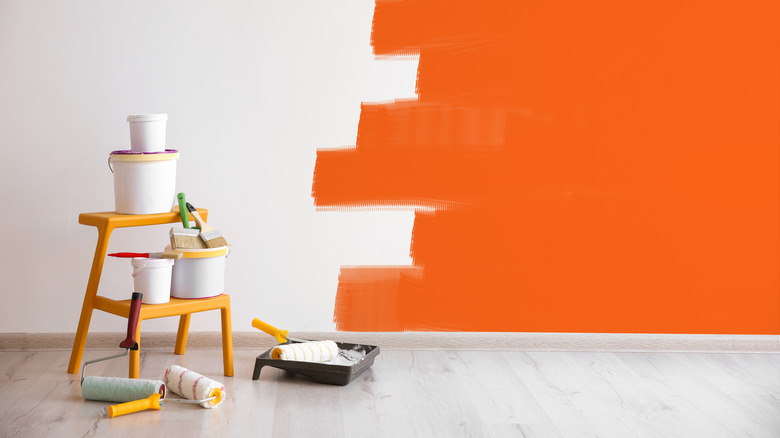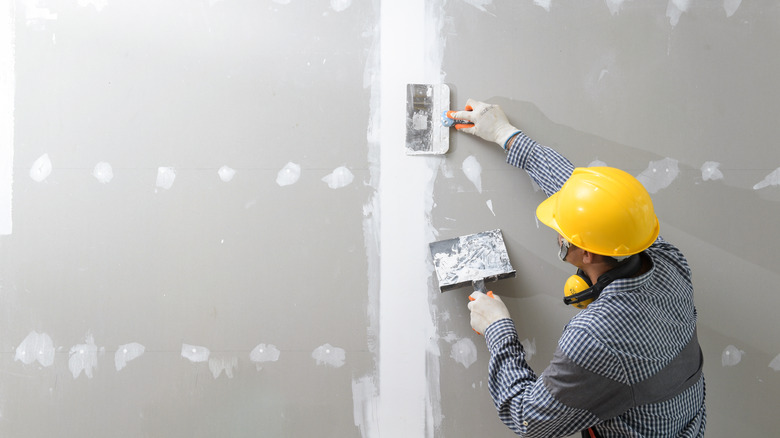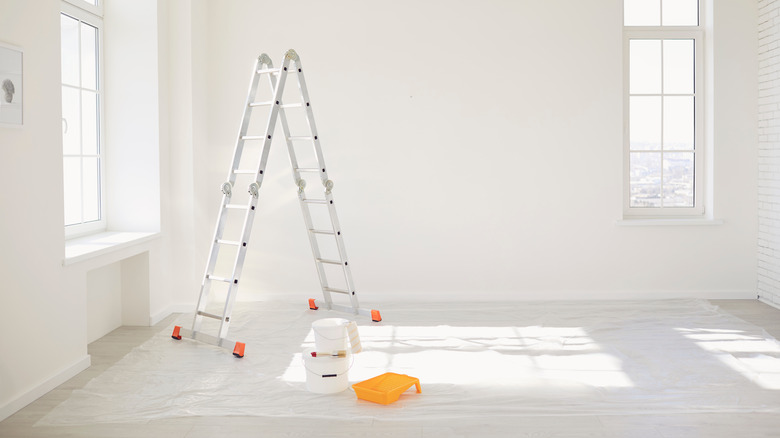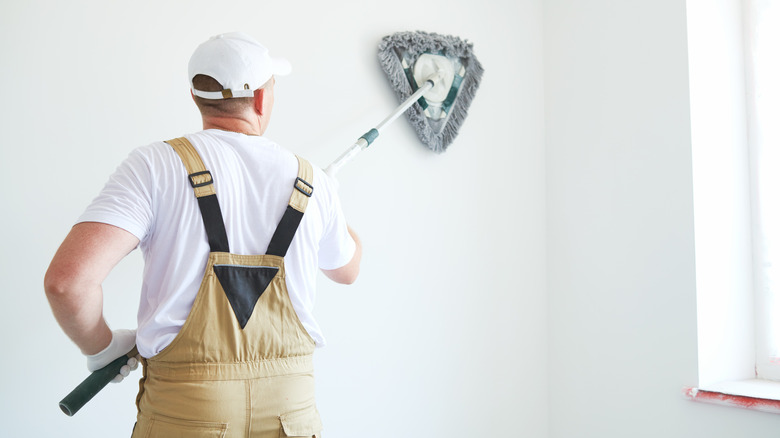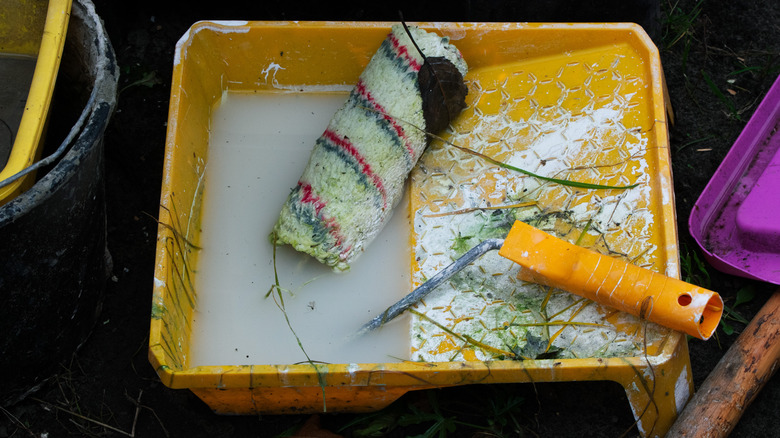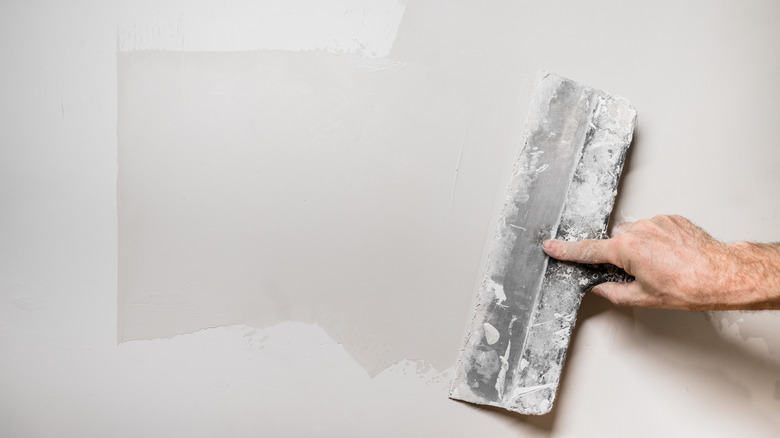The Biggest Scams To Watch For With Painters
Painting is one of the most exciting renovation projects there is — after all, color brings life into a room, and is one of the first steps in turning a house into a home. Dated, dingy walls can bring a space down, but a fresh coat of paint (yes, even on the oldest of walls) can really turn a room around. Even if you didn't purchase an old fixer-upper, you might be questioning the colors the former owners went with, or maybe you're considering a dark and moody accent wall in the dining room.
But let's be real: As much as a paint job can transform a space, doing it DIY style on your own can really transform your day, too — chances are, you'll be miserable, frustrated, covered in primer, and complaining about how sore your arms are for days. But a solid professional painting job can cost upwards of $2,800 for the interior, and over $4,000 for the exterior, says HomeAdvisor — ouch. Nonetheless, if your budget allows you to go with a pro painting job, make the most out of your time and money, and keep an eye out for these common contractor scams.
Avoid unlicensed and uninsured painters
A lack of insurance or license is one of the most common red flags for "professional" painters, but fortunately, it's easy to catch before any work gets started. While not all states require painters to be registered, it's important to keep note of your own location's laws regarding licensure before signing any contracts.
CertaPro Painters explains that obtaining a license is actually a painless and simple process in most states. So, if your prospective contractor does not have a license, that's a likely sign that they're not completely serious about their profession — or your particular gig. CertaPro warns that this can end up with a painter up and leaving before the work is complete, leaving you with zero left in your painting budget and back at square one. Of course, that may not always be the case, but it's worth digging deeper into your state's licensure laws to ensure that you're hiring the right team for the job and to get the best result possible.
Licensing aside, it's crucial that the painter(s) you hire are fully insured. TLC Painting Inc. says that this is where fraud runs rampant in the painting world — if your contractor doesn't have any liability insurance and an employee gets hurt in your home, you'll be the one stuck with the bill.
Unspecified or vague contracts can cost you more
When asking for an estimate for a painting job, you always want to be as specific as possible — that's how you separate the scam artists from the pros. If a company is offering vague terms and conditions, or won't fully clarify the work that's needed ahead of time, then you may want to take your business elsewhere.
One of the most common areas where homeowners run into unexpected costs is the expectation on the number of coats required for a job. A group of professional painters shared how they handle this on the forum PaintTalk, with most agreeing that typically, estimates and contracts should be for two or three coats. Some even say that if a job is done in fewer coats than specified, they'll work with the customer to provide a partial refund for the unneeded materials and labor. But if a contract is for an unspecified number of coats, it's possible that the painter may try to get away with less than what's needed. You can avoid this simple scam by providing as much information as possible to the contractor during the walk through. Always specify your desired paint color and finish, and come to a written agreement on the number of anticipated coats.
Poor painting prep work is a red flag
Even the most amateur DIYers know that painting a room doesn't start with the color on the walls — it starts with cleaning and preparing the walls. You can't properly paint a surface covered in dust and dirt, and you certainly can't refinish the siding of a home when it's splintered and far from paint-ready.
Inexperienced painters may try to pass themselves off as more reputable contractors, but the easiest way to spot the lack of expertise in their work is by making note of any prep work. If your contract doesn't specify any cleaning before the paint — we're talking down to the actual cleaners and methods that they plan to use — don't sign it! If you've already sealed the deal and you happen to notice that the painters skipped preparing the walls and went straight to paint, you may be in the midst of a common paint scam, says This Old House. The job may not hold up that well over time if it's not properly prepared for, and you may end up paying a professional price tag for the same DIY effort you could have done on your own!
Keep an eye out for any material changes
No homeowner is going to sit around and watch paint dry just for the fun of it, and that's totally fair. But that's exactly how some scam artists end up making out with some extra cash — if you aren't aware of the materials used, you may end up getting ripped off.
Some scammers completely swap out the actual paint product used, like this homeowner on Houzz, who requested (and paid for) a Sherwin Williams color. The approved sample was Sherwin Williams, but the owner noticed that the contractor was using a cheaper brand of paint without their approval. While some painters may need to swap brands and color match to fit time and material constraints, that should always be cleared with the customer, and the new product should be the same quality — if not better.
As if that wasn't enough to worry about, some scammers have found a way to make a few extra bucks by watering down your more expensive materials. Crash of Rhinos Painting explains that it is typical for professional painters to thin out paint using water, which makes it easier to work with and improves the overall quality of the job. However, some painters take it a step further and fully water down your expensive paint, far beyond the standard "thinning" threshold. This makes the product go further with significantly less coverage, but all at the same cost — which you'll be paying either way!
Be wary of last minute repairs
Sadly, this is one of those scams that you may not catch on too until it's too late, which is why it's so crucial to pick the right company for the job. Spectrum Painting LLC says that it's not unusual for shoddy painters to add on one, two, or even more additional fees at the end of the project. A few hundred here for a small patch job that you didn't see in the walkthrough, another thousand there to replace some drywall out of the blue — some scammers might stack up the charges on your bill like it's nothing!
The same goes for damage that may occur to the rest of your home while the contractors are working. Do your best to document the current state of the landscaping or room and surrounding area before the work gets started. If there's any existing damage, take a photo and note it in the contract, recommends This Old House. That way, you won't be hit with sudden costly side projects (like fixing scratched floors or cracked windows) once the painting is done.
Of course, sometimes these charges are completely valid, so you'll have to do your own part in investigating whether or not they were really necessary. Request that your contractor check in with you for any major updates before they complete any surprise work — if they refuse to and fix "problems" without alerting you, there may have never been a problem at all.
